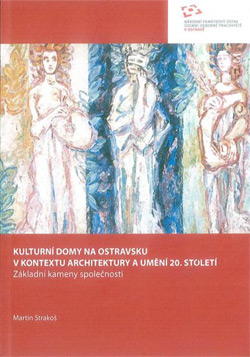
New publication by Martin Strakoš about cultural houses in the Ostrava region
Source
Mgr. Petra Batková, tiskový referát NPÚ ÚOP v Ostravě
Mgr. Petra Batková, tiskový referát NPÚ ÚOP v Ostravě
Publisher
Tisková zpráva
15.05.2013 14:10
Tisková zpráva
15.05.2013 14:10
 |
The work “Cultural Houses in the Ostrava Region in the Context of 20th Century Architecture and Art: Cornerstones of Society” focuses on the genesis of the cultural house as a specific architectural type. It mentions the development from national houses and theaters to modern multifunctional cultural buildings. It also provides contemporary domestic reflections on cultural building projects within Czechoslovakia (Masaryk Cultural House in Mělník) as well as examples from other European countries (Slovakia, Poland, Soviet Union, Great Britain).
A section follows that focuses on the development of cultural buildings in the Ostrava region, including references to unrealized designs of cultural houses from the period just before and just after World War II. The discussion then shifts to projects and realizations of cultural houses in small municipalities and mining enterprises in Ostrava, which reflected the ideas of functionalism as well as the emerging socialist realism and Brussels style.
An important block consists of chapters dealing with cultural houses in the new satellite towns and housing estates of Ostrava, which were realized mainly in the second half of the 1950s. Externally and in terms of layout, these are examples of modern classicism, while late modernism is indicated in the interiors through the Brussels style or a certain minimalism of forms. The most significant monument of this type is the House of Culture of the Working People of Ostrava (now the House of Culture of the City of Ostrava) from 1954 to 1961 by architect Jaroslav Fragner. Other presented cultural houses include the Cultural House Poklad in Ostrava-Poruba, the Cultural House Akord in Ostrava-Zábřeh, the Cultural House Petra Bezruče in Havířov, the Cultural House of the City of Karviná, the Cultural House in Hlučín, or the Těšín Theater in Český Těšín.
The conclusion of the book is devoted to specific examples of architectural culture, including the heritage protection of cultural houses. It mentions the relationship between the heritage-protected object and a new architectural layer in the form of the dominance of the new or an emphasis on an equal dialogue between the new architecture and the monument.
The English translation is powered by AI tool. Switch to Czech to view the original text source.
1 comment
add comment
Subject
Author
Date
Přednáška Martina Strakoše v Klubu Za starou Prahu
Petr Šmídek
17.05.13 09:50
show all comments
Related articles
0
18.08.2021 | The House of Culture Poklad in Ostrava-Poruba will reopen on August 25 after nine years
0
20.05.2021 | In Ostrava, they are completing the reconstruction of the Cultural House Poklad
0
19.02.2018 | New contract for the reconstruction of DK Poklad in Ostrava will likely be in spring
0
11.04.2017 | The completion of the House of Culture Poklad in Ostrava will be halted again
0
02.11.2016 | The completion of the Culture House Poklad in Ostrava will take longer and be more expensive
0
11.05.2016 | The House of Culture Poklad in Ostrava is expected to begin renovations in August












